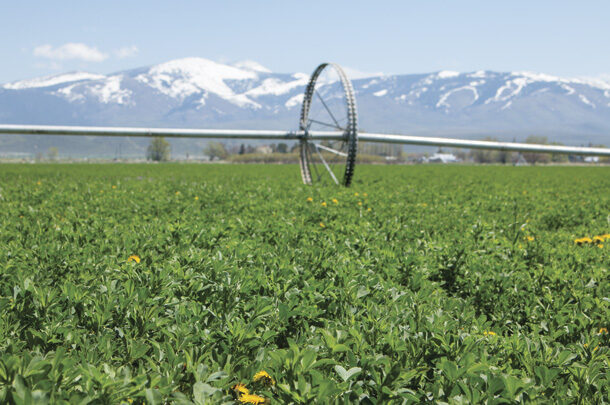“I want to plant more alfalfa so I don’t have to fertilize as much.” If I had a nickel for every time I have heard that, I would have a lot of nickels!
That statement might apply to nitrogen fertilization of alfalfa, but all other nutrients need to be applied depending on soil and/or tissue levels. In fact, alfalfa consumes quite a bit of a couple of nutrients that we will concentrate on in this article.
While much has been written about the fertility needs of crops like grasses and corn silage, we as an industry don’t talk about alfalfa as often, so perhaps we can all share the blame for allowing this idea of not fertilizing alfalfa to persist so long. I’ll concentrate mainly on phosphorus (P) and potassium (K) in this article, but be aware that some micronutrients like boron and molybdenum are critical too, and the soil needs to be tested for them and fertilizer applied accordingly.
Phosphorus
The concentration of phosphorus in alfalfa is fairly consistent across forage tests from different time points and geographies. It follows then, that the amount of phosphorus needed for a given field is tied directly to the yield. The more tons you take off, the more phosphorus the crop needs. Table 1 shows the amount of phosphate fertilizer needed to achieve hay yields from 5-9 tons per acre across the top and some example soil test levels down the left side.

What does phosphorus deficiency look like? Almost all the time, it looks like fewer bales in the field than there should be. In other words, the classical signs of phosphorus deficiency from a textbook are very rarely seen in the field. And by the time those signs do appear, you have lost a huge amount of production. In the plant, phosphorus is vital to many processes. One interesting observation has been that plants low in phosphorus have fewer and smaller nodules on them as well as a lower concentration of nitrogen inside the nodules. So to get the most “free nitrogen” that we expect from alfalfa, we have to make sure the plant has enough phosphorus.
Potassium
Potassium (called potash by some) is usually the most critical nutrient in an alfalfa fertility program because it is taken up in such large quantities by the plants. The uptake of potassium is a bit more complicated than phosphorus, so Table 2 takes into account both the soil test level in the left-hand column and soil cation exchange capacity (CEC) across the top.

These numbers can be found on your soil tests for your fields. Yield matters too, of course, but this table assumes a yield of 5 tons per acre. So when you deal with a particular field, you need to know the expected yield, soil test level and the CEC. All of these factors will change the amount of potassium needed.
The authors of this table capped the amount of potassium added (as K2O) at 300 pounds per acre because they felt any more would result in such luxury consumption that there might be a danger of milk fever if the forage was fed in large quantities. Luxury consumption of potassium in alfalfa is not observed as often as it is in grasses, but it is certainly possible.
But unlike phosphorus, feed tests compared between locations and harvest dates can vary widely because of this luxury consumption. It is not wise to just assume your levels will all be like the first cutting for the rest of the season, especially if potassium fertilizer is applied midseason. How high is too high for potassium? Just like grasses, levels above 2.5% potassium on a dry matter basis are a cause for concern.
What does potassium deficiency look like? It can often look like a weedy stand or a stand that had more severe winterkill than neighboring fields. Alfalfa fields with adequate potassium levels initiate regrowth after cutting much faster than fields that are deficient. Potassium also plays an important role in winterhardiness. Again, this damage is done before you see the classic symptoms.
Timing of fertilization
For many years, the recommended time to apply P and K fertilizer was one application in the fall. The thinking was that most of the potassium would be taken up by the roots before winter and the phosphorus needed sufficient time in the soil to become plant-available. By spring, the phosphorus would be ready to be used by the alfalfa plants. This system works and has worked very well for a number of years.
But as alfalfa yields keep getting pushed higher and higher, some fields are running out of P and K after a few cuttings. As stated earlier, many times it isn’t bad enough for the classic deficiency signs to appear, but there is a drop in yield that can be raised by a late spring application (especially of potassium). When you consider that each ton of hay removes 6 pounds of phosphorus and about 50 pounds of potassium, you can imagine that fields fertilized just enough to get them to the desired level by the first cut in the spring will be low after just a couple of cuttings. Another thing worth mentioning is that since alfalfa is a luxury consumer of potassium, even if you apply a year’s worth in the fall, the plants will take up more than they need by early spring, and the potassium could leave the field in the first cutting or two.
These two factors have led to the recommendation of splitting P and K into two applications, one after the last cut in the fall and one between first and second cutting in the spring. The fall application will drive yield in the first two cuttings in the spring, and the late spring application will carry through the rest of the growing season. Dairy farms that haul manure throughout the year are getting their split applications on if they haul manure to a field more than once in the growing season. The exact ratio of how much should be applied in the first or second application isn’t totally settled, so most people split the applications evenly.
And I’ll leave you with a thought about that “free” nitrogen. Many of the best alfalfa growers are applying up to 30 units of nitrogen with new seedings of alfalfa. This is to supply nitrogen to the seedling plants before the nodules are fully functional. There are numerous reports of an increased yield in the first year by supplementing a small amount of nitrogen at planting.
As always, when it comes to soil fertility, field history is critical. No matter if it is phosphorus, potassium or even nitrogen applied to your alfalfa, the fertility needs of a field that gets frequent manure applications will not be the same as the hay field that you can’t quite remember if you fertilized last year. Soil testing is the only way to know for sure what is needed.












